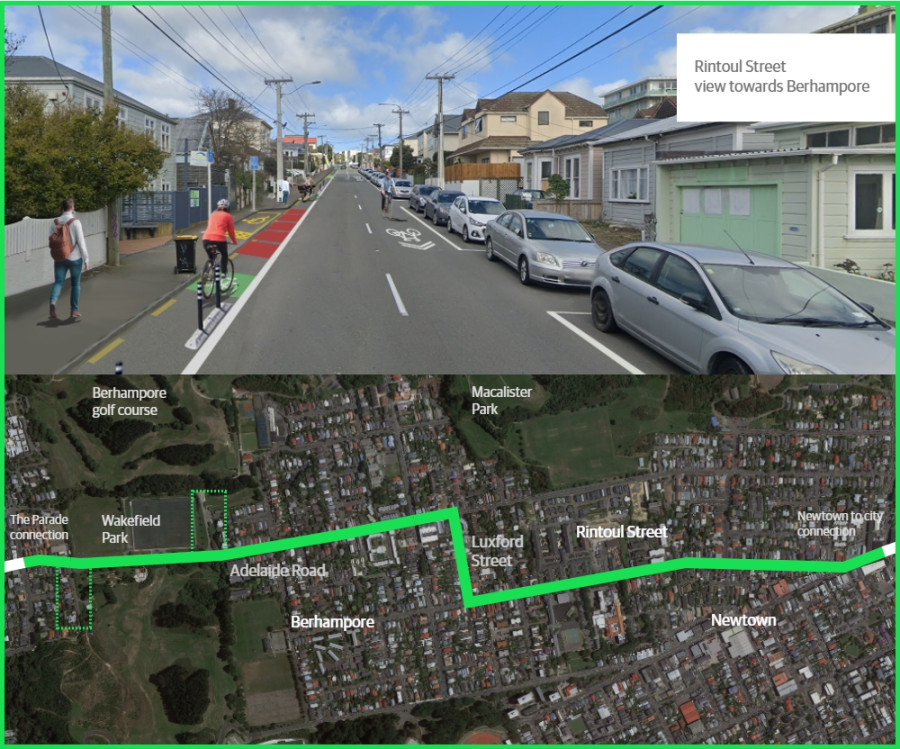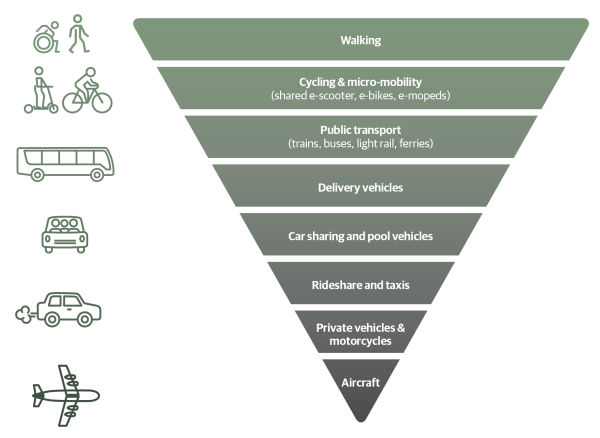
He tāone e hāngai ana ki te anamata
A city fit for the future
The busy inner-city suburbs of Berhampore and Newtown are growing and in future will have a lot more people living here in townhouses and apartments. If we don’t support this growth with better transport options, these suburbs will grind to a halt.
This project will give people better options for getting to and around Berhampore and Newtown, and to the wider city, without having to rely on a car. The changes will make it safer and easier to walk, scoot, bike, or take the bus to schools, workplaces, sportsgrounds, community facilities, shops, cafes, and businesses.
Project at a glance
This project will make things safer and easier for everyone and complete the bike connection between Island Bay and the central city. Improvements along the route will include:
- new raised pedestrian crossings, raising some existing crossings and improving others
- moving some bus stops so there is better spacing between stops
- longer bus stops and new bus platforms on Adelaide Road, Rintoul Street and Luxford Street
- bike lanes and parking changes/removal on the uphill sections of Rintoul Street (retaining parking for Newtown Medical Centre including the mobility park) and Adelaide Road (between The Parade and Berhampore shops)
- bike lanes and parking changes/removal on both sides of Luxford Street and the northern end of The Parade (with new speed humps at Dee Street roundabout)
- bike lanes and parking changes/removal on Riddiford Street between Mein Street and Rintoul Street to connect with the existing lanes
- a new off-street paved parking area on Dover Street
- new bike parking for cargo bikes at Wakefield Park
- slower speeds (we are applying to the NZ Transport Agency Waka Kotahi to extend the 30km/h speed zone along the whole route, from Dee Street to Riddiford Street).
Improvements at Berhampore shopping area include:
- a raised crossing at the Adelaide/Herald/Chilka intersection and a new signalised crossing at Britomart Street
- a speed hump at the left-turn slip lane from Luxford Street into Adelaide Road
- removing the right turn from Luxford Street into the southern part of Rintoul Street
- slower speeds and a speed feedback sign for vehicles.
How the work is happening
Work has started and we expect to complete the project about mid-2024.
Find out more about how we're rolling out changes
Newtown/Berhampore parking plan
To manage on-street parking in the area more fairly, we’re also proposing changes for people who park on the street in Newtown and Berhampore. A new parking scheme will change where people can park and for how long.
Berhampore shopping area
We’ve worked with the Berhampore community and local businesses to make Berhampore village more appealing and accessible.

Stay in touch and get involved
We're keen to involve the community as we go, so we will be sending updates when there are opportunities to get involved or have your say.
Got questions about the project? Email newtownberhampore@wcc.govt.nz
- Waka Kotahi NZ Transport Agency, which is funding the project through their Streets for People programme
- Greater Wellington Regional Council (including Metlink).
Wellington is expected to grow over the next 30 years, which will dramatically affect the way our city look, feels, and operates. If we continue at our current rate of car use, our transport network will grind to a halt.
Our goal is to be a city where people of all ages and abilities can move easily and freely, and people have the option to walk, bike, scoot or use public transport. These essential street changes will make it easier for more of us to be less reliant on our cars.
We’re proposing to make it safer and easier for people to move around in climate-friendly ways. The transport changes we’re developing will take time to get used to, but we need to adapt to make sure we can get to our destinations.
Paneke Pōneke is our plan for a citywide bike network that will be installed alongside improvements for people walking, scooting, and taking the bus. Bus stop changes on these routes are part of delivering the Bus Priority Action Plan.
Planned new crossings will be installed using permanent materials, but new bike lanes will be created using adaptable materials. This approach allows interim biking and scooting improvements to be installed quickly, so people can start using the routes faster, and then give feedback so the route can be refined further for future permanent improvements.
This new approach and the bike network plan, Paneke Pōneke, went out for consultation in November 2021, and was approved by Councillors on 10 March 2022.
Island Bay to Newtown connection
Having a safe biking connection into the central city from the south coast via Island Bay, Berhampore and Newtown was proposed back in 2013/14 when changes were first planned and made in Island Bay. The Island Bay section was the first of four sections proposed to complete the connection from the south. Three of the fours sections are now in place. The improvements planned to the route between north Island Bay and Newtown will complete the route.
Planning and discussion about the two sections through Berhampore and Newtown began almost 10 years. A citizens’ advisory panel, and others, began assessing potential cycling facilities in Berhampore and Newtown. In 2017, the Our Town Newtown project also sought feedback on the future of Newtown.
In late 2018, we sought feedback on three options - different packages of routes and street changes. Four public drop-in sessions were held, and we also met with a range of groups and organisations.
We heard from more than 770 people during the first phase of community discussion (5 June–17 July 2018) on the Newtown connections project. Of those, 85% thought it was important or very important to make it easier and safer for more people to ride bikes in and around the wider Newtown area. This information was used to develop a community brief which includes a set of community objectives that were used to help guide the development of the three proposed packages of routes and street changes that we sought feedback on in late 2018 (13 November–11 December). More than 1000 people gave feedback on these three packages.
Further engagement was put on hold until the Parking Policy had been consulted on (August 2020) and mass rapid transit routes were confirmed by Let’s Get Wellington Moving.
As part of the Long-term Plan 2021-2031, Councillors voted to invest $226m in a safe, connected citywide bike network. They requested a new bike network plan (Paneke Pōneke) to get changes made more quickly.
In September 2021, Councillors gave the go-ahead for interim improvements on the Newtown to the city route via Adelaide Road and Kent/Cambridge terraces.
Wellington is expected to grow over the next 30 years, which will dramatically affect the way our city looks, feels, and operates. If we continue at our current rate of car use, our transport network will grind to a halt.
Our goal is to be a city where people of all ages and abilities can move easily and freely in climate-friendly ways. These essential street changes will make it easier for more of us to be less reliant on our cars.
We’re changing our streets to make it safer and easier for people to walk, ride, scoot, or use public transport. The changes we’re developing will take time to get used to, but we need to adapt to make sure we can still get around.
In line with Council strategies, policies, and plans, we have developed Paneke Pōneke, a citywide bike network plan. Changes as part of Paneke Pōneke will happen alongside improvements for people walking, scooting, and taking the bus.
Making it safe and easy to bike, walk, and use public transport for everyday trips is key to rapidly cutting emissions in Wellington. It’s vital that we create a connected network, particularly for beginners and less confident riders, as well as people who are experienced riders, so that more of us can get around more often in low carbon ways.
The following strategies, policies, plans and research provide the context for the development of a safe, connected and high-quality bike network alongside other sustainable transport improvements.
Sustainable transport hierarchy
Our sustainable hierarchy was first adopted in the Urban Growth Plan 2015 (now superseded by the Spatial Plan). The hierarchy prioritises movement by walking, biking, and public transport, so that our city’s streets work better for people.

Paneke Pōneke Bike Network Plan 2022
The bike network will connect suburbs to the city centre and destinations, helping to get people of various ages and abilities from where they live to where they work, study, shop, and play. Paneke Pōneke, Wellington’s bike network plan, was adopted in March 2022.
We consulted on the bike network plan between 2 November – 14 December 2021 as part of the Our City Tomorrow engagement. This engagement also included the draft District Plan and options for mass rapid transit routes through Let’s Get Wellington Moving.
Long-term Plan 2021-2031
The Long-term Plan updated the city outcomes and priority objectives. It also provided $226 million over 10 years to develop a bike network. This is supported by investments in Let's Get Wellington Moving, which will provide for safe biking in the city centre and key corridors connecting to the city centre.
Spatial Plan 2021
The Spatial Plan 2021 provides a blueprint for more housing to accommodate a growing population over the next 30 years. This includes supporting tens of thousands more people to live in the inner-city suburbs and within walking distance of the city centre and rapid transport stops.
A well-connected walking and biking network is key to accommodating more people in the city without adding to car congestion or putting pressure on our bus services.
Greater Wellington Regional Council, Wellington Regional Land Transport Plan 2021
This plan sets out the strategic direction for transport investment across the Greater Wellington region, including targets to reduce transport emissions and increase the proportion of people walking, biking, and using public transport.
Wellington Regional Land Transport Plan 2021
Parking Policy 2020
The Parking Policy provides a framework to guide future decision-making on the management of all Council-controlled parking spaces, and how parking supports achieving the vision for Wellington. The Parking Policy refers to the sustainable transport hierarchy, which gives highest priority to active modes of transport, such as walking, biking, and public transport. This means that when we make decisions on using road space, these active modes take a higher priority to parking.
Te Atakura First to Zero Blueprint and Implementation Plan 2019
We aim to become a net zero carbon city by 2050. Road transport emissions represent 34% of our city’s emissions – making them the single biggest source. Electric vehicles alone can’t solve this problem, given their relative expense. Making it safe and easy to bike, walk, and use public transport for everyday trips is key to rapidly cutting emissions in Wellington.
Te Atakura - First to Zero Blueprint and Implementation Plan 2019
Previous cycling strategic documents
- Wellington Cycle Network Strategic Case 2015: This outlines the challenges related to cycling and how achieving the objectives will benefit Wellingtonians.
- Cycling Framework 2015: This set out a decision-making process for the bike network and how it would be developed. It should be noted that design guidelines for what makes a safe bike lane are continually being developed and we expect to take account of current guidance as we plan improvements.
- Cycling Demand Analysis 2014: This research investigated how different types of cycling infrastructure is likely to affect the numbers of people choosing to cycle in Wellington and assessed the demand for improvements.